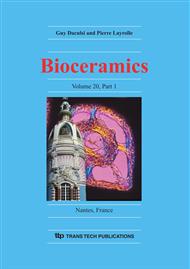p.657
p.661
p.665
p.669
p.673
p.677
p.681
p.685
p.689
Characterization of Titanium Oxide Thin Films Produced by Plasma Immersion Ion Implantation for Biomedical Implants
Abstract:
Plasma immersion ion implantation (PIII) is a very attractive method for the surface treatment of titanium hard tissue replacements such as hip joints and enhancement of the mechanical, chemical and biological properties of titanium. It has been considered as an alternative to form protective and hard oxide films on titanium and titanium-based implants. In this study, titanium oxide (TiO2) thin films were formed on titanium using PIII, which produces films with adhesion superior to those prepared with conventional techniques. The films were analysed by atomic force microscopy (AFM), X-ray diffraction (XRD) and pull test.
Info:
Periodical:
Pages:
673-676
Citation:
Online since:
November 2007
Authors:
Price:
Сopyright:
© 2008 Trans Tech Publications Ltd. All Rights Reserved
Share:
Citation:


